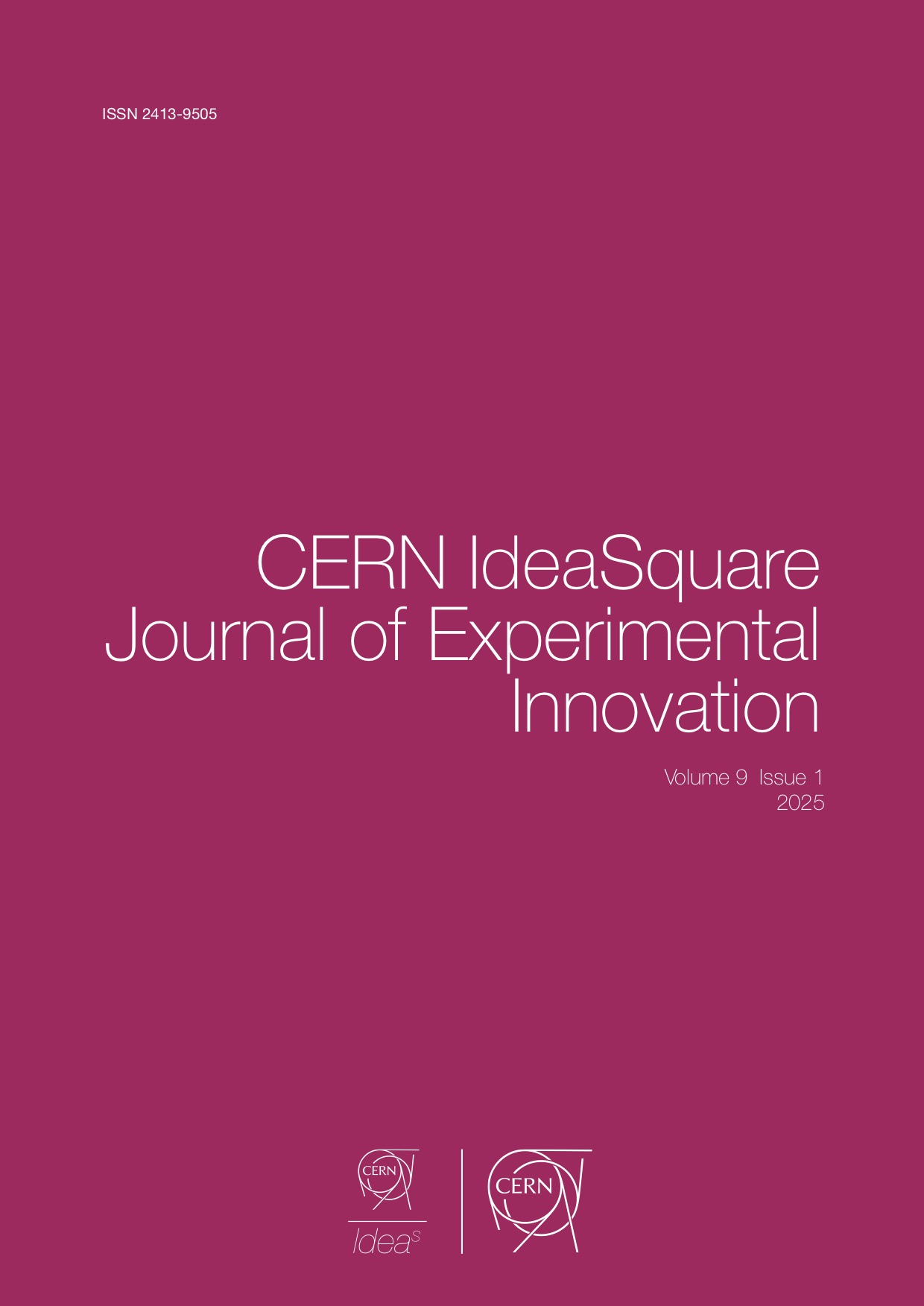Exploring the Role of Art in Stimulating Creative Thinking and Problem-Solving within Interdisciplinary STEM-Dominated Student Groups: Insights from Art-Related Activities at CERN IdeaSquare
DOI:
https://doi.org/10.23726/cij.2025.1486Keywords:
Art in innovation, creative thinking, art strategies, problem-solving within groups, creativity and innovationAbstract
Art as a form of creative expression is increasingly recognized as a tool to break through creative barriers in the innovation process. However, there has been little research on the impact of artistic endeavours on the creative thinking and problem-solving abilities of groups comprised mostly of STEM students working on an innovation project, and how art influences the development of novel ideas and solutions. This study explores the impact of four art-related activities - creating visuals, dancing ice-breakers, listening to background music and working within the uniquely designed CERN IdeaSquare environment - on creativity and the innovation process of members in different interdisciplinary teams. A survey was conducted to assess the activities’ effects on motivation, focus, imagination and divergent thinking. The study specifically examines how students from predominantly STEM fields perceived the role of art in innovation and creativity. These activities took place during a two-week course. The paper highlights visual art as a primary driver of creative thinking, whereas other artistic activities that did not directly contribute to the end goal are considered hindrances in the creative process.
References
Acai, A., McQueen, S., McKinnon, V., & Sonnadara, R. (2016). Using art for the development of teamwork and communication skills among health professionals: a literature review. Arts & Health, 9(1), 60–72. https://doi.org/10.1080/17533015.2016.1182565
Acar, S., & Runco, M. A. (2012). Creative abilities. In Elsevier eBooks (pp. 115–139). https://doi.org/10.1016/b978-0-12-374714-3.00006-9
Amabile, T. M. (1996). Creativity and Innovation in Organizations. In Harvard Business School (Nr. 9-396–239). https://edisciplinas.usp.br/pluginfile.php/4927750/mod_resource/content/0/Creativity%20and%20Innovation%20in%20Organizations.pdf
An, D., & Youn, N. (2018). The inspirational power of arts on creativity. Journal of Business Research, 85, 467–475. https://doi.org/10.1016/j.jbusres.2017.10.025
Barry, D., & Meisiek, S. (2010). Seeing more and seeing differently: sensemaking, mindfulness, and the workarts. Organization Studies, 31(11), 1505–1530. https://doi.org/10.1177/0170840610380802
Bast, G., Carayannis, E. G., & Campbell, D. F. J. (2015). Arts, research, innovation and society. In Springer eBooks. https://doi.org/10.1007/978-3-319-09909-5
Bell, S. K., Pascucci, R. C., Fancy, K. M., Coleman, K., Zurakowski, D., & Meyer, E. C. (2014). The educational value of improvisational actors to teach communication and relational skills: Perspectives of interprofessional learners, faculty, and actors. Patient Education and Counseling, 96(3), 381–388. https://doi.org/10.1016/j.pec.2014.07.001
Bertram, D. (2006). Likert Scales: . . .are the meaning of life (CPSC 681). Retrieved September 15, 2023, from https://pages.cpsc.ucalgary.ca/~saul/wiki/uploads/CPSC681/topic-dane-likert.pdf
Bradborn, S. (2010). Creative Arts in Group Work. In CASA Forum. Victorian Centres Against Sexual Assault. Retrieved September 10, 2023, from https://casa.org.au/assets/Documents/Creative-Arts-in-Group-Work.pdf
Chapter 4: Innovation and creativity. (ca. 2011). In Developing the Cambridge learner attributes (1st ed.).
Dalton, A. (2015). Foster Critical Thinking: The pARTnership Movement. In Americans for the Arts. Americans for the Arts. Retrieved September 11, 2023, from https://www.americansforthearts.org/sites/default/files/pARTnership_CriticalThinking.pdf
Dam, R. F. (2024, 28 september). The 5 Stages in the Design Thinking Process. The Interaction Design Foundation. https://www.interaction-design.org/literature/article/5-stages-in-the-design-thinking-process?srsltid=AfmBOoqOlVFt0j0LcQSzR4Xbymxs5RcgUZwdkvR6PW1evtvqXkRm5Atj
Gencer, H. (2019). Group dynamics and behaviour. Universal Journal of Educational Research, 7(1), 223–229. https://doi.org/10.13189/ujer.2019.070128
GmbH, A. (2020, 13 mei). Divergent thinking. airfocus. https://airfocus.com/glossary/what-is-divergent-thinking/
Hilliard, R. E. (2006). The effect of music therapy sessions on compassion fatigue and team building of professional hospice caregivers. The Arts in Psychotherapy, 33(5), 395–401. https://doi.org/10.1016/j.aip.2006.06.002
Hindi, N. (2016, May 17). Why Art May Be Key In Innovation. The Artian. https://theartian.com/2016/05/17/why-art-may-be-key-in-innovation/
Imagination. (2024). https://dictionary.cambridge.org/dictionary/english/imagination
Isaak, J. (2022). Effect of Art Media on the Collective Mood of a Middle School Art Therapy Group: A Development of a Method Therapy Group: A Development of a Method [MA thesis]. Lesley University.
Kampylis, P., & Berki, E. (2014). Nurturing creative thinking. International Academy of Education, UNESCO. https://publications.jrc.ec.europa.eu/repository/handle/JRC81937
Mukunda, N., Moghbeli, N., Rizzo, A., Niepold, S., Bassett, B., & DeLisser, H. M. (2019). Visual art instruction in medical education: a narrative review. Medical Education Online, 24(1), 1558657. https://doi.org/10.1080/10872981.2018.1558657
Paul, A., Mercado, N. R., Block, L., DeVoe, B., Richner, N., & Goldberg, G. R. (2023). Visual thinking strategies for interprofessional education and promoting collaborative competencies. The Clinical Teacher. https://doi.org/10.1111/tct.13644
Sheingold, B., Warson, E., Lunsford, B., & Pintz, C. (2014). Using Art Therapy Techniques for Team Building in Distance Education Doctor of Nursing Practice Student Cohorts. Journal of Interprofessional Healthcare, 1(1), 4.
Stokes, D. (2014). The role of imagination in creativity. In Oxford University Press eBooks (pp. 157–184). https://doi.org/10.1093/acprof:oso/9780199836963.003.0009
Walker, M. A. (2010). Concept-based inquiry into art making: The possibility of change through art [PhD dissertation]. Columbia University.
Williams, B. (2002). Using collage art work as a common medium for communication in interprofessional workshops. Journal of Interprofessional Care, 16(1), 53–58. https://doi.org/10.1080/13561820220104168
Downloads
Published
How to Cite
License
Copyright (c) 2025 Silvia Grigorescu, Svetoslav Yordanov, Luca Chicoş, Nikodem Dudek

This work is licensed under a Creative Commons Attribution 4.0 International License.
Authors who publish with this journal agree to the following terms:
- Authors retain copyright and grant the journal right of first publication with the work simultaneously licensed under a Creative Commons Attribution License that allows others to share the work with an acknowledgement of the work's authorship and initial publication in this journal.
- Authors are able to enter into separate, additional contractual arrangements for the non-exclusive distribution of the journal's published version of the work (e.g., post it to an institutional repository or publish it in a book), with an acknowledgement of its initial publication in this journal.
- Authors are permitted and encouraged to post their work online (e.g., in institutional repositories or on their website) prior to and during the submission process, as it can lead to productive exchanges, as well as earlier and greater citation of published work (See The Effect of Open Access).


